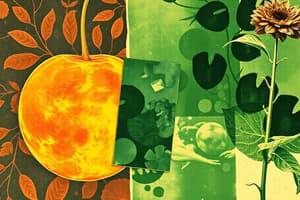Podcast
Questions and Answers
What is the color of Phaeophytin?
What is the color of Phaeophytin?
- Yellow-brown
- Bright green to blue green
- Yellow-grey (correct)
- Yellow-green to olive green
Which pigment is responsible for the yellow-brown color?
Which pigment is responsible for the yellow-brown color?
- Yellow Carotene
- Xanthophyll (correct)
- Chlorophyll b
- Chlorophyll a
What is the color of Chlorophyll a?
What is the color of Chlorophyll a?
- Yellow
- Yellow-brown
- Bright green to blue green (correct)
- Yellow-green to olive green
Which pigment has a yellow-green to olive green color?
Which pigment has a yellow-green to olive green color?
What is the color of Yellow Carotene?
What is the color of Yellow Carotene?
What is the main function of the middle lamella?
What is the main function of the middle lamella?
What is the term used to describe the movement of chloroplasts in a cell?
What is the term used to describe the movement of chloroplasts in a cell?
Which organelle is responsible for storing starch in potato cells?
Which organelle is responsible for storing starch in potato cells?
What is the function of the nucleolus?
What is the function of the nucleolus?
Flashcards are hidden until you start studying
Study Notes
Cell Structure and Components
- Vacuoles are fluid-filled spaces not occupied by cytoplasm.
- Robert Hooke discovered the cell, and Robert Browne discovered the nucleus.
- The nucleolus is located inside the nucleus.
Cell Wall and Composition
- The cell wall can be stained using an iodine solution, which also stains the vacuole and nucleus.
- The organized arrangement of cells in the cell wall of Allium cepa (onion) is due to cellulose.
- The cementing substance between cells is called the middle lamella.
- The middle lamella is composed of calcium, pectins, and magnesium.
Cellular Movement and Organelles
- The movement of green bodies (chloroplasts) is called cytoplasmic streaming or cyclosis.
- In this movement, chloroplasts move in a clockwise direction.
Specific Organelles and Plant Examples
- Chromoplasts are found in tomatoes.
- Amyloplasts, which store starch, are found in potatoes.
- The nucleus is visible in onions.
- Chloroplasts are present in Hydrilla verticillata.
- Tradescantia spathacea lacks vacuoles.
Studying That Suits You
Use AI to generate personalized quizzes and flashcards to suit your learning preferences.




